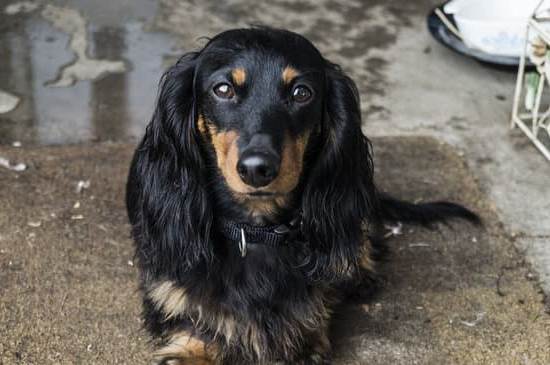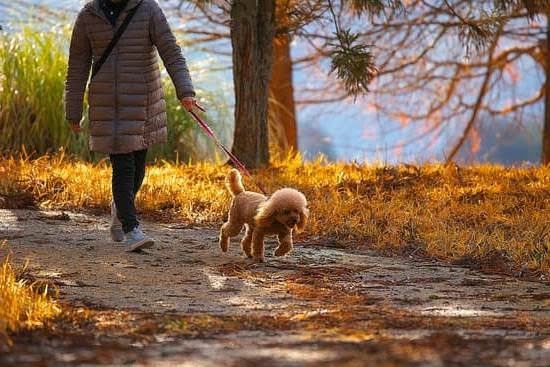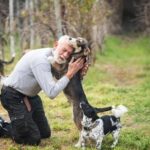Dogs have a natural tendency to jump on people, whether it’s out of excitement, affection, or simply to get attention. However, this behavior can become problematic and even dangerous, especially when it comes to larger or more energetic dogs. In order to have a well-behaved companion, it is important to train your dog not to jump on you or others.
In this article, we will explore the reasons why dogs jump on people and why it is crucial to address this behavior. We will also discuss the common mistakes that owners make when trying to prevent their dogs from jumping and highlight the key ingredient for success in training: consistency.
To effectively train your dog not to jump on you, we will provide a step-by-step guide that includes setting boundaries and establishing rules, teaching the “off” command, and using positive reinforcement techniques. Additionally, we will share additional training techniques such as ignoring and redirecting attention, using a leash or harness for control, and exercising your dog to eliminate excess energy.
We’ll also address specific challenges such as jumping on guests and how to handle situations where your dog jumps when excited or during playtime. Furthermore, we’ll emphasize the importance of socialization and consistency beyond training in order to reinforce good behavior.
By following the advice in this article and implementing these training techniques consistently, you can enjoy a well-behaved dog who no longer jumps on you or others. So let’s dive in and explore how to train your dog not to jump.
Why is it important to train your dog not to jump on you?
Jumping is a common behavior in dogs, often seen as a way to greet and show excitement. However, it can be a problem when your furry friend jumps on you or your guests. This is why it is crucial to train your dog not to jump on you.
Firstly, jumping can be physically dangerous, especially for young children, seniors, or individuals with mobility issues. A large dog jumping on someone can cause them to lose balance and potentially result in injury. By training your dog not to jump on you, you are ensuring the safety of yourself and others.
Additionally, allowing a dog to jump on you can reinforce unwanted behaviors and set a bad precedent for other interactions. When a dog jumps up to greet you, they are seeking attention and reinforcement. If their behavior is rewarded with petting or affection from you, they will continue to engage in this behavior whenever they want attention. Training your dog not to jump helps establish boundaries and reinforces the desired behavior of greeting people calmly.
Furthermore, training your dog not to jump enhances their social skills and makes them more enjoyable to be around. People appreciate well-behaved dogs who greet them politely without jumping up on them. By teaching your dog proper manners, you are setting them up for success in various social settings and ensuring that they can have positive interactions with both familiar faces and strangers.
Common mistakes owners make when trying to prevent their dogs from jumping
When it comes to training a dog not to jump, there are several common mistakes that owners often make. These mistakes can impede the progress of training and make it difficult for the dog to understand what is expected of them. By identifying and avoiding these mistakes, owners can improve their chances of successfully teaching their dog not to jump.
- Inconsistency in enforcing rules: One common mistake is being inconsistent with enforcing rules regarding jumping. Dogs thrive on consistency, so if they are allowed to jump on certain individuals or in certain situations but not others, they will become confused about what behavior is acceptable. It’s important for all members of the household to be on the same page and enforce consistent rules when it comes to jumping.
- Lack of clear boundaries: Another mistake is failing to establish clear boundaries for the dog. Dogs need clear guidelines about what behavior is appropriate and what is not. Without clear boundaries, they may not understand that jumping is unacceptable in certain situations or with certain people. Owners should clearly communicate expectations through consistent reinforcement and positive rewards for desired behavior.
- Negative reinforcement: Using punishment or negative reinforcement methods can also be a mistake when trying to prevent dogs from jumping. Punishing a dog for jumping can create anxiety or fear, which may exacerbate the problem rather than solve it. Instead, focusing on positive reinforcement techniques will help reinforce desired behaviors and encourage the dog to learn and repeat them.
By recognizing these common mistakes and avoiding them, owners can increase their chances of success when training their dogs not to jump. Consistency, clear boundaries, and positive reinforcement are key factors in achieving lasting results in this aspect of training a well-behaved pet.
- Inconsistency in enforcing rules
- Lack of clear boundaries
- Negative reinforcement
The key to success
Consistency in training is the key to successfully teaching your dog not to jump on you. Dogs thrive on routine and repetition, so it’s crucial to be consistent in your approach. By maintaining consistency, you help your dog understand that jumping behavior is not acceptable in any situation.
Setting boundaries and establishing rules
One important aspect of consistency in training is setting clear boundaries and establishing rules for your dog. Dogs need to understand what behaviors are allowed and what behaviors are off-limits. Consistently enforcing these boundaries will help your dog learn more quickly and effectively.
Start by setting clear rules about when it is appropriate for your dog to jump, such as during playtime or when given a specific command. Teach them that jumping is not allowed during other times, like when greeting people or sitting quietly at home. By consistently enforcing these rules, your dog will begin to associate jumping with negative consequences.
Teaching the “off” command
Another way to maintain consistency in training is by teaching your dog the “off” command. This command teaches your dog to remove all paws from the person or object they are jumping on. Start by using a calm and firm voice when giving the command, and reward your dog with treats or praise when they respond correctly.
Consistency is key in reinforcing this behavior through repetition. Practice the “off” command in different situations and with various people so that your dog learns it applies universally. With time and patience, consistent reinforcement of the “off” command will result in a well-trained dog who knows not to jump on you or others.
Using positive reinforcement to reward desired behavior
Consistency goes hand-in-hand with positive reinforcement when training a dog not to jump. Rewarding desired behavior helps reinforce the message that jumping is undesirable while alternative behaviors are rewarded.
Whenever your dog refrains from jumping on you, make sure to reward them with treats, pets, or verbal praise. Consistently rewarding this desired behavior will motivate your dog to continue behaving appropriately. Additionally, be consistent in withholding rewards when your dog does jump on you or others. By consistently providing positive reinforcement for desired behavior and withholding it for undesired behavior, your dog will learn which actions lead to rewards and which do not.
By being consistent in setting boundaries, teaching the “off” command, and using positive reinforcement, you can successfully train your dog not to jump on you. Remember that consistency is key throughout every step of the training process to ensure a well-behaved and non-jumping dog.
Step-by-step guide on how to train a dog not to jump on you
One of the most effective ways to train a dog not to jump on you is by following a step-by-step guide. By breaking down the training process into manageable steps, you can teach your dog to greet you in a calm and polite manner. Here are some key steps to consider when training your dog not to jump on you:
Setting boundaries and establishing rules
The first step in training your dog not to jump on you is setting clear boundaries and establishing rules. Dogs thrive on consistency and structure, so it’s important to establish what behaviors are acceptable and what behaviors are not. For example, you can teach your dog that jumping is only allowed when given a specific cue or command.
Teaching the “off” command
Once you’ve set boundaries, it’s time to teach your dog the “off” command. This command is used to communicate that jumping is not allowed and that all four paws should be on the ground. You can start by saying “off” firmly but calmly as soon as your dog jumps up. As soon as their paws touch the floor, reward them with praise or a treat.
Using positive reinforcement to reward desired behavior
Positive reinforcement is an effective training technique that involves rewarding your dog for exhibiting the desired behavior. When teaching your dog not to jump on you, it’s essential to reward them for keeping all four paws on the ground. This can be done through verbal praise, treats, or affectionate petting. By consistently reinforcing this positive behavior, your dog will learn that staying calm results in rewards.
| Training Step | Action Taken | Progress Made |
|---|---|---|
| Setting boundaries and establishing rules | Established clear rules for when jumping is allowed and not allowed | Dog starting to understand the boundaries |
| Teaching the “off” command | Started using the “off” command when dog jumps on you | Dog showing signs of understanding the command and responding appropriately |
| Using positive reinforcement to reward desired behavior | Rewarded dog with verbal praise and treats when they keep all four paws on the ground | Dog consistently staying calm and no longer jumping up on you |
Additional training techniques to reinforce good behavior
Ignoring and redirecting attention
In addition to teaching the “off” command and using positive reinforcement, another effective training technique to reinforce good behavior and prevent jumping is ignoring and redirecting attention. Dogs often jump as a way to seek attention from their owners or to get a desired response. By ignoring the jumping behavior, you can take away the reward that your dog seeks.
When your dog jumps on you, simply turn your back and avoid making eye contact or speaking until they calm down. Once they have settled all four paws on the ground, reward them with praise or treats. It’s important to remain consistent with this technique so that your dog learns that jumping will not get them the attention they desire.
Redirecting your dog’s attention can also be helpful in preventing jumping. Teach your dog an alternative behavior such as sitting or offering a paw when they approach you. By redirecting their focus onto a more appropriate behavior, you can reinforce good manners and discourage jumping.
Using a leash or harness to provide control
Using a leash or harness can be an effective tool to reinforce good behavior and prevent jumping, especially during greetings or encounters with unfamiliar people. Before allowing your dog to greet someone, have them sit or stand in a controlled position next to you. If your dog starts to jump, gently pull back on the leash or use it as a deterrent by stepping on it to create tension.
The leash provides physical control and prevents your dog from being able to jump up freely. Make sure not to yank the leash too hard as this could cause discomfort or injury. With consistent use of the leash or harness during greetings, your dog will learn that jumping is not acceptable behavior.
Remember to always combine leash control with positive reinforcement, praising and rewarding your dog for displaying appropriate greeting behaviors such as sitting calmly without attempting to jump.
Exercising your dog to eliminate excess energy
One common reason why dogs jump on people is due to an excess amount of pent-up energy. Regular exercise and physical activity can help eliminate this excess energy, reducing the likelihood of jumping behavior.
Engage in daily exercise routines with your dog such as walking, running, or playing fetch. Provide mental stimulation through interactive toys or training sessions. By giving your dog the appropriate outlets for their energy, they will be less likely to resort to jumping as a means of expending their excess energy.
Ensure that your dog’s exercise routine aligns with their breed and size, as different breeds have varying levels of exercise requirements. A tired dog is a well-behaved dog, so make sure to incorporate regular exercise into their daily routine to reinforce good behavior and prevent jumping.
By incorporating these additional training techniques into your repertoire, you can reinforce good behavior in your dog and prevent them from jumping on you or others. Remember to remain patient and consistent in your training methods, providing clear boundaries and rewards for desired behavior. With time and practice, you’ll enjoy the company of a well-behaved, non-jumping dog.
Troubleshooting
Dealing with specific challenges when it comes to training a dog not to jump on you can be frustrating, but with the right techniques and consistency, these challenges can be overcome. In this section, we will address some common scenarios where dogs tend to jump and provide tips on how to handle them.
Jumping on guests:
One of the most common challenges is dealing with a dog that jumps on guests when they enter your home. To prevent this, it’s important to teach your dog proper greeting manners. Start by practicing the “off” command with your dog consistently before guests arrive.
When someone enters your home, have your dog sit calmly beside you and reward them for staying down. If your dog does jump up, ask your guest to ignore the jumping behavior and turn away until your dog calms down. Once your dog is calm and has all four paws on the ground, allow them to approach and greet the guest calmly.
Jumping when excited or during playtime:
Dogs often jump when they are excited or during playtime. It’s important to redirect their behavior in these situations. Reinforce an alternative behavior such as sitting or offering a toy instead of jumping. Use positive reinforcement techniques such as giving treats or praise for good behavior. Consistently reinforcing these alternative behaviors will help redirect your dog’s excitement into more appropriate actions.
Jumping on children or seniors:
When dealing with dogs that have a tendency to jump on children or seniors, it’s crucial to prioritize safety for both parties involved. Supervise interactions closely between your dog and young children or elderly individuals. Teach children how to properly interact with a dog by showing them how to ask for appropriate behavior without encouraging jumping. For example, they can ask the dog for a high-five instead of allowing the jumping behavior.
Remember, training takes time, patience, and consistency. By addressing these specific challenges and using the techniques mentioned in this section, you can effectively train your dog not to jump on you and others. With practice and reinforcement, your dog will learn to greet people calmly and appropriately.
| Specific Challenge | Troubleshooting Tips |
|---|---|
| Jumping on guests | – Practice “off” command before guests arrive
|
| Jumping when excited or during playtime | – Redirect with alternative behaviors (e.g. sitting, offering a toy)
|
| Jumping on children or seniors | – Supervise interactions closely
|
The importance of socialization and consistency beyond training
Many dog owners understand the importance of training their dogs to not jump on them or other people. However, it is equally important to recognize that socialization and consistency are key components of maintaining a well-behaved, non-jumping dog in the long run. This section will explore the importance of socialization and consistency beyond training.
Socialization plays a crucial role in ensuring that your dog behaves appropriately in various situations and around different people. By exposing your dog to different environments, individuals, and experiences, you can help them develop confidence and learn how to interact politely with strangers. Socializing your dog can include taking them on walks in public places, visits to parks, enrolling in obedience classes or training courses, and arranging playdates with other dogs.
Consistency is vital in reinforcing the lessons you have taught your dog during training sessions. Dogs thrive on routine and predictability; therefore, it is essential to maintain consistent expectations for their behavior at all times.
This means that everyone in the household should be on the same page when it comes to reinforcing rules and boundaries. If one family member allows jumping while another discourages it, confusion may arise, making it more difficult for the dog to understand what is expected of them.
Beyond training sessions, it is important to continue practicing the learned behaviors by incorporating them into everyday life. For example, if your dog has learned not to jump on guests during training sessions, make sure they also apply this behavior when visitors come over. Reinforce these positive behaviors by praising your dog whenever they demonstrate self-control.
By emphasizing socialization and consistency beyond training sessions, you can ensure that your furry friend becomes a well-mannered member of society who greets others politely without jumping. With patience and dedication to ongoing reinforcement of desired behaviors, you will enjoy the companionship of a non-jumping dog who can confidently navigate different environments and interact appropriately with people they encounter along the way.
Conclusion
Training a dog to not jump on people can greatly improve your relationship with your furry companion and the experience of interacting with them. By following the steps outlined in this article, you can enjoy the benefits of having a well-behaved, non-jumping dog.
A dog that doesn’t jump on people is not only more pleasant to be around, but it also shows respect for personal boundaries and helps prevent any potential accidents or injuries. Dogs love attention and jumping up on people is their way of seeking it. However, through consistent training, you can teach your dog alternative ways to seek attention and greetings without resorting to jumping.
It’s important to remember that training a dog takes time and patience. Consistency in training is key to achieving the desired results. By setting boundaries and establishing rules from the beginning, you are sending a clear message to your dog about what behavior is acceptable and what isn’t. Reinforce these boundaries consistently by implementing positive reinforcement techniques, such as rewarding your dog for good behavior.
In addition to the step-by-step guide provided in this article, there are other training techniques that can reinforce good behavior in your dog. Ignoring and redirecting attention when your dog jumps up can communicate that jumping will not lead to getting what they want.
Using a leash or harness during interactions with guests or in public places can provide you with control over your dog’s movements and prevent jumping. Regular exercise can also tire out your dog both physically and mentally, reducing their excess energy levels which may contribute to jumping behaviors.
Through proper socialization and consistency in training techniques, you can achieve success in training your dog not to jump on you or others. Remember that each situation might present different challenges, such as jumping on guests or jumping when excited during playtime. Troubleshoot these specific challenges by applying the techniques discussed throughout this article.
Additional resources and recommended tools for successful training
Training a dog not to jump on you requires time, effort, and patience. Thankfully, there are additional resources and tools available that can aid in the training process and ensure your success.
One valuable resource is professional dog trainers or behaviorists who specialize in obedience training. They have the experience and knowledge to assist you in overcoming specific challenges and provide personalized guidance tailored to your dog’s needs. It can be beneficial to seek their help if you are struggling with certain aspects of the training or if your dog’s jumping behavior persists.
Another helpful tool is the use of training aids such as clickers or treat pouches. Clickers provide an audible signal that signifies when your dog has performed the desired behavior correctly, which can enhance communication between you and your furry friend during training sessions. Treat pouches allow for easy access to rewards so that you can quickly reinforce positive behavior on the spot.
Additionally, there are books, videos, and online courses available that offer comprehensive guides on dog training techniques. These resources can provide detailed step-by-step instructions along with visual demonstrations to further support your learning process. Make sure to choose reputable sources that align with positive reinforcement methods for effective and humane training.
Remember, consistency is key when it comes to successful training. By utilizing additional resources and recommended tools, you can enhance your understanding of how to train a dog not to jump on you and increase your chances of having a well-behaved companion.
By investing time into proper training techniques and utilizing all available resources at your disposal, you will enjoy the benefits of a canine companion who greets visitors politely without jumping up on them. With patience, persistence, and love, you will build a strong bond with your dog while teaching them good manners that will last a lifetime.
Frequently Asked Questions
What is the best way to stop a dog from jumping on you?
The best way to stop a dog from jumping on you is to be consistent with training and using positive reinforcement techniques. It’s important to teach the dog an alternative behavior, such as sitting or staying, which they should do instead of jumping.
Whenever the dog tries to jump, redirect their attention and reward them for performing the desired behavior. Consistency is crucial in this process, so everyone interacting with the dog should follow the same approach and provide clear boundaries.
How do I train my dog not to jump on guests?
Training your dog not to jump on guests requires a mix of obedience training, socialization, and teaching impulse control. Start by setting up controlled interactions with friends or family members who are willing to participate in the training. Use a leash or have your dog wear a harness to have better control over their actions during these sessions.
When guests arrive, ask them not to greet your dog until they have settled down calmly. Reward your dog when they remain calm and offer an appropriate greeting instead of jumping. Gradually increase the difficulty by introducing more distractions while reinforcing the desired behaviors consistently.
How do I get my dog to stop biting and jumping on me?
To stop a dog from biting and jumping on you, it’s important to address both issues separately but simultaneously. Firstly, tackle the biting behavior by ensuring your dog has enough mental stimulation and appropriate chew toys available.
Redirect their attention towards these toys whenever they start biting you or jumping on you aggressively. Additionally, establish clear rules and boundaries through consistent training, rewarding good behavior, and ignoring or redirecting unwanted behaviors appropriately.

Welcome to the blog! I am a professional dog trainer and have been working with dogs for many years. In this blog, I will be discussing various topics related to dog training, including tips, tricks, and advice. I hope you find this information helpful and informative. Thanks for reading!





